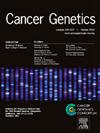BRCA1的串联重复和三次重复:通过光学基因组定位重新审视大基因组重排
IF 2.1
4区 医学
Q4 GENETICS & HEREDITY
引用次数: 0
摘要
人类基因组内的大基因组重排(lgr)越来越被新的全基因组技术所认识,但迄今为止可能被低估。这类基因组变异包括拷贝数变异,如编码或非编码基因组区域的重复或三倍。在这里,我们报告了两个靶向BRCA1的lgr,两个独立家族的外显子18-19的重复和外显子1-2的三倍。利用光学基因组图谱(OGM)、全基因组测序(WGS)和cDNA分析,研究了这些lgr的基因组组织和转录组效应。我们发现,靶向BRCA1外显子18-19的串联重复ogm[GRCh38]dup(17)(q21.31q21.31)(43057052_43063373)预计会产生一个过早终止密码子,即p.(His1732Metfs*10)。BRCA1外显子1-2 ogm[GRCh38]trip(17)(q21.31q21.31)(43117155_43124115)也是按顺序排列的。转录本显示插入了内含子2的一小部分(chr17:43,121,558-43,121,676),理论上也会产生一个过早终止密码子。总的来说,OGM和WGS有助于阐明这些lgr的体系结构。然而,最终的管理取决于这些LGR的功能后果如何得到充分的澄清。在转录水平上对lgr进行更深入的研究对于获得有关治疗决策的准确结论至关重要。本文章由计算机程序翻译,如有差异,请以英文原文为准。
Tandem duplication and triplication in BRCA1: revisiting the large genomic rearrangements via optical genome mapping
Large genomic rearrangements (LGRs) within the human genome are becoming more recognized by novel genome-wide technologies and may be underreported so far. This class of genomic variation includes copy number variations like duplications or triplications of coding or non-coding genomic regions. Here, we report two LGRs targeting BRCA1, a duplication of exons 18–19 and a triplication of exons 1–2 in two independent families. Utilizing Optical Genome Mapping (OGM), Whole Genome Sequencing (WGS) and cDNA analysis, we characterized the genomic organization and transcriptomic effects of these LGRs regarding its. We show that the tandem duplication ogm[GRCh38]dup(17)(q21.31q21.31)(43057052_43063373), targeting BRCA1 exon 18–19 is predicted to generate a premature termination codon, namely p.(His1732Metfs*10). The triplication of BRCA1 exon 1–2 ogm[GRCh38]trip(17)(q21.31q21.31)(43117155_43124115) is also sequentially arranged. The transcript shows an insertion of a small part of intron 2 (chr17:43,121,558–43,121,676) that theoretically will generate a premature termination codon as well. Collectively, OGM and WGS help elucidating the architecture of these LGRs. However, the final curation depends on how adequate the functional consequences of these LGR can be clarified. Deeper investigation of LGRs on transcript level is important to attain accurate conclusions with respect to therapeutic decisions.
求助全文
通过发布文献求助,成功后即可免费获取论文全文。
去求助
来源期刊

Cancer Genetics
ONCOLOGY-GENETICS & HEREDITY
CiteScore
3.20
自引率
5.30%
发文量
167
审稿时长
27 days
期刊介绍:
The aim of Cancer Genetics is to publish high quality scientific papers on the cellular, genetic and molecular aspects of cancer, including cancer predisposition and clinical diagnostic applications. Specific areas of interest include descriptions of new chromosomal, molecular or epigenetic alterations in benign and malignant diseases; novel laboratory approaches for identification and characterization of chromosomal rearrangements or genomic alterations in cancer cells; correlation of genetic changes with pathology and clinical presentation; and the molecular genetics of cancer predisposition. To reach a basic science and clinical multidisciplinary audience, we welcome original full-length articles, reviews, meeting summaries, brief reports, and letters to the editor.
 求助内容:
求助内容: 应助结果提醒方式:
应助结果提醒方式:


